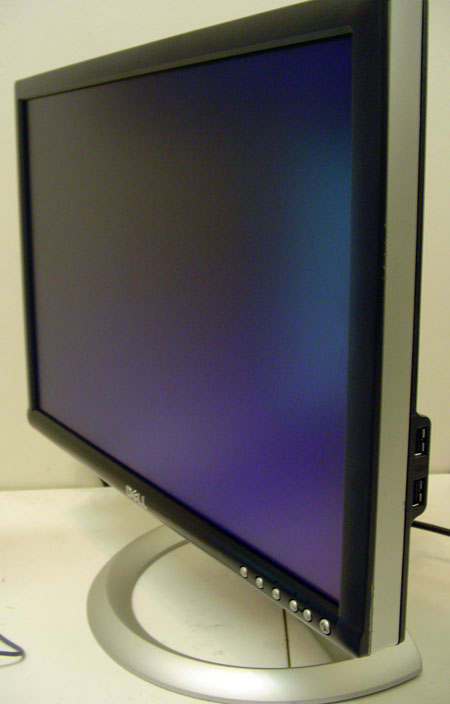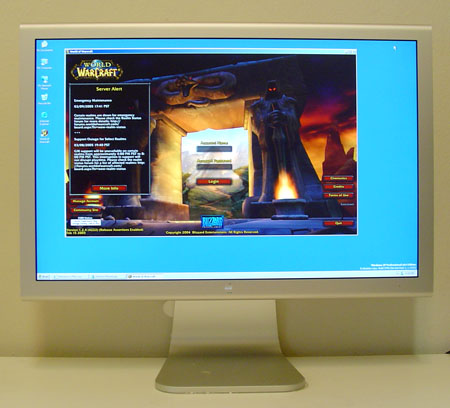The 20" LCD Shootout: Dell versus Apple
by Kristopher Kubicki on April 27, 2005 12:05 AM EST- Posted in
- Displays
Specifications
Although both the Apple and Dell 20" displays use the same LG.Philips LCD LM201W01 panel, Apple and Dell seem to differ (at least in terms of marketing) on several specifications including response time, contrast ratio and brightness. Granted, Dell and Apple use different backlights that may account for the 50 nit difference. On the other hand, Apple hardware is traditionally listed with slightly conservative specifications. Part of our review process is to evaluate these specifications anyway - and since these are nearly identical displays, it will be very easy for us to verify which model has the more accurate listed specifications.| Apple Cinema Display 20" M9177LL | |
| LCD Panel | 20.1" WSXGA+ LCD (Active Matrix) pixel pitch: 0.258mm Anti-glare coating Super IPS Panel |
| Advertised Scanning Frequency | Horizontal: 31-83kHz Vertical: 56-75Hz |
| Advertised Response Time | 16ms (Typical) |
| Advertised Viewing Angle | 170 / 170 (Horizontal / Vertical) |
| Advertised Contrast Ratio | 400:1 (Typical) |
| Compatibility | 1680 x 1050 (Native) |
| Advertised Brightness | 250 cd/m2 |
| Warranty | 1 year parts and labor |

| Dell UltraSharp 2005FPW | |
| LCD Panel | 20.1" WSXGA+ LCD (Active Matrix) pixel pitch: 0.258mm Anti-glare coating Super IPS Panel |
| Advertised Scanning Frequency | Horizontal: 31-83kHz Vertical: 56-75Hz |
| Advertised Response Time | 12ms (Typical) |
| Advertised Viewing Angle | 176 / 176 (Horizontal / Vertical) |
| Advertised Contrast Ratio | 600:1 (Typical) |
| Compatibility | 1680 x 1050 (Native) |
| Advertised Brightness | 300 cd/m2 |
| Warranty | 3 years parts and labor |
Oddly, Dell lists their 2005FPW with a typical response time of 12ms while Apple and the panel manufacturer both claim a 16ms response time. Over the last several months, we have seen display manufacturers claim only the rising response time on their product specifications. Given the track record of most manufacturers to inflate contrast ratios using favorable testing techniques, the likelihood that accurate response time measurements are starting to crumble to more aggressive marketing seems high. Of course, anyone who reads our display reviews on a regular basis can probably tell you that "average" (TrTf) response time has very little to actual responsiveness of the display and that other specifications, like color depth and display mode, can be more helpful when purchasing a new monitor.
The M9177LL utilizes very different native resolution than what we have seen in the past. LG.Philips LCD largely pioneered the WSXGA+ signal resolution found on the Cinema display and we saw our first demonstrations of the technology back at the Consumer Electronics Show in January of 2004. Since then, WSXGA+ has gained a bit of popularity in laptops, but not in LCD TVs. Unfortunately with HD signals broadcast at 1280x720 or 1920x1080, all of the XGA+ signals pioneered by LG.Philips require some signal conversions, which result in skewed pixels or skewed signals. While watching WMV9 samples on our Cinema display, we attempted to overcome this by only viewing windowed 720p movies, but unfortunately, a bit of screen real estate is wasted in the process. We can't penalize Apple or Dell for trying, however, and both the 23" and 30" Cinema displays incorporate resolutions large enough to play unaltered 1080p signals.
The strongest aspect of the LG.Philips LCD panel utilized in the Cinema display is ultimately the 8-bit Super IPS display. We have covered some displays in the past that utilize 16ms and 12ms 6-bit TN displays. We have never been in favor of sacrificing color depth for response time, but some insist that the sub 20ms response time is absolutely critical to their usage. We will get more into various usage benchmarks later on.
For those not familiar with LCD display modes and how they work, feel free to check out our LCD FAQ from 18 months ago. To reiterate, the fundamental problem with any LCD is that when the LCD liquid crystals "twist" (or "untwist"), there is ultimately a several millisecond delay. This delay translates into a several millisecond delay on the LCD screen. This is unfortunately complicated by the fact that displays do not simply twist the crystal on or off, but at one of 255 degrees (for 8-bit displays) or 63 degrees (for 6-bit displays). Obviously, two states that are very close to each other take less time than two states further apart from each other, which results in pixels that are not just delayed in a uniform manner, but at several different speeds across the entire panel depending on the hue. This generates motion blur, but is commonly misnamed as ghosting (which is a different problem that we will talk about later).
Super IPS counters motion blur by simply aligning the individual fibers that make up the crystal in a particularly easy alignment, without sacrificing viewing angle. Please refer to the FAQ if you would like to know more about SIPS in particular and how it stacks up against PVA, MVA or TN.
We were very surprised to learn that the Apple Cinema 20" display only comes with a one-year limited warranty, if you do not purchase the display with a PowerBook or PowerMac. Dell displays all come with a three-year limited warranty.











70 Comments
View All Comments
Weezard - Wednesday, May 4, 2005 - link
Okay, sounds good.So if I buy this monitor, Ill just have to plug it in, and it will work with widescreen and all - on my Windows XP system with 9700Pro?
Thanks.
Pastuch - Wednesday, May 4, 2005 - link
"Does my Radeon9700Pro support this monitor?"A 9700pro is an excellent videocard for this monitor if you dont plan on playing games like Halflife 2 or WoW. The 9700pro's DVI signal will work perfectly, however you should install the latest ATI driver from ATI.com.
"but what about resolution options, DDC (or what its called - the function that delivers 16:10 widescreen). "
DDC or whatever you had in mind does not deliver a widescreen display. If you install the latest ATI drivers you will see that the standard windows graphics profiles in display settings have 1680x1050x32. The ATI driver has the ability to force 720p or 1080i but it is not necessary.
Weezard - Wednesday, May 4, 2005 - link
Hi, nice review.I do have a few questions about the Cinema Display.
Does my Radeon9700Pro support this monitor? It has DVI output, but what about resolution options, DDC (or what its called - the function that delivers 16:10 widescreen).
Is this a plug and play monitor, when running Windows XP and Radeon 9700Pro? Is any software needed before using it with a Windows OS?
Thank you.
wrack - Wednesday, May 4, 2005 - link
One thing I forgot to ask Kristopher,Which graphics card and processor was used to carry out this review..? I can't find 1680x1050 resolution option on my graphics card.
wrack - Tuesday, May 3, 2005 - link
#54 Electonic circuits always tend to attract fine dust.nortexoid - Sunday, May 1, 2005 - link
dust acts as an insulator? the monitor is standing vertically so the only place dust would gather is on the top, not on any of the electronics. or do you lie your monitor face down on a glass desk and work from underneath the desk? i know it's gaining ergonomic popularity, but i thought only in malawi.Spacecomber - Saturday, April 30, 2005 - link
This is the kind of review that I'd like to see become the standard for comparing LCDs. Pick an assortment of LCDs that are using the same type of matrice panel(TN, IPS, PVA/MVA) and compare these monitors to each other. They don't have to be using the exact same panel, as in this case, just one based on the same technology. This will provide the reader with something much more like an apples to apples comparison than the apples to oranges comparision that you will get otherwise. (Sorry, about the Apple pun.)With all three (or four) types of matrices having such distinctive strengthes and weaknesses, you pretty much have to decide which of these patterns of characteristics will best match how you use the computer and then go looking for that particular type of matrice in a panel.
The questions for the reviewers then becomes how well does a particular display cope with it's inherent weaknesses, as well as how well does it emphasize what should be its relative strengths.
For example, in this Anandtech review of IPS panel displays, one of the main problems for IPS panels to overcome is a relatively low contrast ratio, which can affect how well it reproduces black; so, this specification is one that should be given particular attention in the review, especially the subjective analysis.
Response times are always a point of emphasis in LCD reviews, and with IPS screens, as was noted in the review, you should expect to see the relatively modest black-white response time made up for by the fact that response times stay relatively consistent, even when changes in shade become smaller. (That is why I was confused by this statement, regarding motion blur, in the review, "...two states that are very close to each other take less time than two states further apart from each other, which results in pixels that are not just delayed in a uniform manner, but at several different speeds across the entire panel depending on the hue". I thought that it was with states that were closer together that you saw the slower response time, due to the voltage differential being so small in these cases.)
In sum, I'd like to see more LCD reviews start with what is known about the panel that is being used (such as is detailed in this very good xbitlabs analysis, http://www.xbitlabs.com/articles/other/display/lcd... and use this understanding to provide a framework for comparing LCDs in terms of their strengths and weaknesses. Essentially, while there is no one LCD monitor that is as well rounded for many purposes as is a CRT, anyone buying a LCD will be looking for the one that imposes fewer compromises on the them and for compromises that impinge less on how the screen will be used by that particular buyer.
Space
KristopherKubicki - Friday, April 29, 2005 - link
nortexoid: Dust acts as an insulator. Wrapping your DSP in a warm cuddly blanket will probably make it fail prematurely.glennpratt: Unfortunately I cannot quite vouche for the fact that aluminum really acts as a heat sink on this display. The housing is completely smooth and does not really create additional surface area for heat dissapation. Aluminums ability to transfer heat well only helps if there is additional surface area for the sink to come in contact with air.
In reality, the reason why Apple can get away with a beveled design without any passive exhaust has more to do with the fact that the inverter is housed in a separate brick from the display. Samsung does this too in many of their high end displays.
Anyways - I think Apple just picked Aluminum for looks.
Kristopher
glennpratt - Friday, April 29, 2005 - link
The Apple is made of aluminum which may have affected their decision to leave out the vents (aluminum transfers heat much better the plastic.)nortexoid - Thursday, April 28, 2005 - link
What do you think damages a electronics more: dust falling on them or high temperatures?I'd rather vents in the back of my monitor to prevent higher temperatures than have it completely sealed to keep out that horribly destructive nuclear fallout.